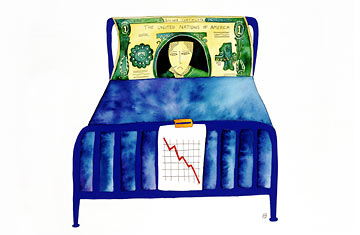
When the sharp abdominal pain hit me earlier this summer, I thought it might be appendicitis. By the time I arrived at the emergency room of a nearby private hospital here in Miami, the pain was excruciating. I wanted to die — no matter what it cost.
Next time, however, I'll try to block out the pain and run the numbers. It turns out I didn't have appendicitis. I had a less serious (albeit briefly unbearable) ailment: a kidney stone, about 3mm in diameter. But don't let that fool you. It was a $12,000 kidney stone.
The total bill came to exactly $11,960. That's for less than four hours in an E.R. bed, intravenous painkillers, CAT scans, a doctor prodding my belly for a minute or so and, lest I forget, the catheter for an emergency urine analysis. The stone passed naturally that same night.
How that added up to $12,000 is an object lesson in how health care expenditures have run amok in this country, and how critical it is that whatever reform bill comes out of Washington this year tackles this economy-wrecking mess. That's especially true in a market like Miami, which holds the dubious distinctions of having one of the nation's lowest median incomes yet its highest medical costs. According to a study released Thursday by Families USA, a Washington-based healthcare watchdog, family health insurance premiums for Florida workers doubled over the past decade, rising four times faster than median earnings.
I don't mean to slight the care I received, which was excellent. And fortunately, the total cost for my insurer was about $7,100 after its discount, a small part of which was my co-payment. But had I not been insured, I would have been stuck with the entire $12,000 bill. Reform advocates say charging even $7,100 for something as ordinary as a kidney stone just doesn't make sense and points up what they call the rampant U.S. practice of "defensive medicine": ordering excessive treatment out of fear of being sued for malpractice, which in turn points up how important malpractice reform is, as President Obama acknowledged this summer. "It underscores the problem of healthcare over-utiization," says Linda Quick, president of the South Florida Hospital & Healthcare Association. "We have to change the way we pay for care and set more appropriate ceilings."
Starting with expensive procedures like CAT scans. The clearer and more comprehensive x-ray imaging known as computerized tomography (CT) is certainly one of the most valuable recent advances in medical technology. But doctors are gorging on it: the number of CAT scans performed in the U.S. each year has leapt more than 200% in the past decade, and a third of them are likely unnecessary, according to the New England Journal of Medicine. The overuse is acute in cities like Miami because doctors and hospitals feel they have to justify the glut of CT machines and related personnel they have on hand.
That's helping to drive costs through the roof. I had no idea when they wheeled me into the CT salon to detect my kidney stone that I was getting not one but two CAT scans performed — abdominal and pelvic — at almost $3,500 a pop. I've since learned from medical experts that one would have sufficed. And even if my insurance provider did end up paying closer to $2,000 for each scan, that's still well above the less than $1,500 average CT screening cost in the U.S.
When I later asked the hospital why two had been ordered, I was told, "That's the doctor's decision." But his call amounted to what was probably a redundant 30% of a $12,000 bill. "Physicians and radiologists and the like, they all make up their own protocols for the scans," says Dr. Alan Whiteman, associate dean of health services at Barry University in Miami. "A lot of that needs to change."
Another "protocol" that left me bewildered was the $3,013 charge for the physician's care. It was coded on the bill as Level 5 — the highest, what you would think would be charged for, say, shooting victims or massive coronary patients. While I was admittedly in epic pain during those few hours when the stone drilled its way from kidney to bladder, my case was nowhere near life-threatening. Again, I was simply told, "The doctor determined your care was of the nature reflected by the level that's on the bill."
To be fair, the E.R. care level often has less to do with the severity of the case than with the diagnostic work required of the physician. Still, $3,000 for diagnosing a kidney stone "is unfortunately all too typical in Miami," says one South Florida healthcare expert — a big reason the average annual private healthcare provider costs for a family of four in the city is a remarkable $20,282.
A possible remedy, which could get funding in a federal reform bill, is a healthcare delivery model called Patient-Centered Medical Homes. PCMH links patients up with personalized healthcare teams in their communities, which in turn provide more focused, efficient and less costly medical services. An important PCMH feature is making non-emergency care — like less expensive urgent care — more 24/7 accessible to patients who really don't require emergency-level attention. (My kidney stone hit me at night, when my local urgent-care clinic was closed, leaving me with little choice but an E.R.) PCMH "is something we need to encourage because it redirects health care in ways that can save us a lot of money," says Dr. John Rock, dean of the Florida International University College of Medicine in Miami.
In the meantime, when I'm next visited by a kidney stone, I plan to ask for more than a quick death. I'll also request a cost rundown.
